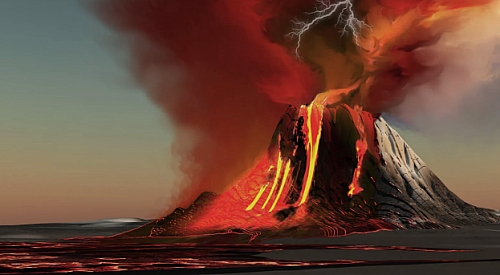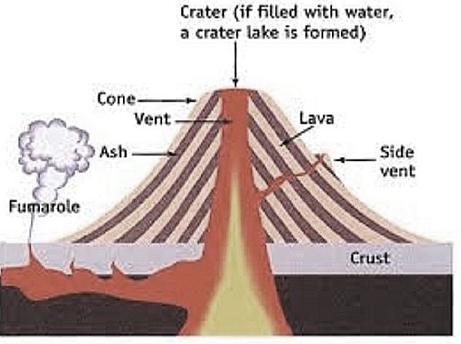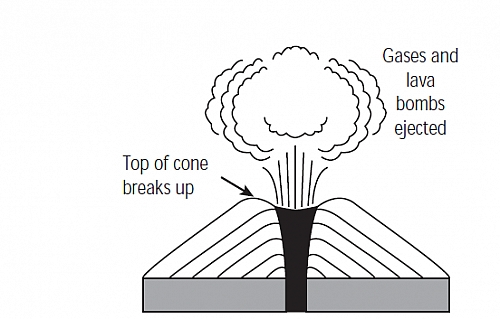Table of Contents
Definition of Volcano
A volcano is defined as a hill or mountain that has an opening through which, ashes gases, cinder etc are forced out in an eruption; or a volcano is a landform that is created by the ejection of gases, lava, ashes and/or molten rock material which escaped through the vent and have become solidified on the surface of the earth.
Volcanoes usually take place where there are tectonic plate boundaries, and it is believed that 80% of the worlds present active volcanoes are located along the border of the continents and the oceans. The ash ejected from volcanoes is known to be very rich in minerals, it is usually extremely fertile for plant growth. Therefore, humans have often risk the chance of eruption for the opportunity to farm the fertile soils of volcanic areas. In some other cases, it is the volcanic activity itself which provides the land upon which people can live (for example, this is seen in the volcanic islands such as the Iceland on the Mid Atlantic Ridge). Another importance of volcanic activity is seen in Iceland where geothermal energy is harnessed from the volcanic activity, and is used to provide heating for the nation.
Volcano Formation
When there is a release of extreme temperature from the radioactive minerals in the interior of the earth, it causes the rocks of the lower part of lithosphere to melt. This melted rock flows out to the earths crust through the cracks or weak points. This erupted materials which is known as Lava, gradually accumulated surrounding the vent and creates a high landform which is called Volcano. However, on the crest of the volcano, there is a forepart with vertical slopes which is known as crater. This crater through a tunnel is linked with the magma in the interior of the earth. Sometimes the molten materials instead of ejecting out may be solidified inside. After ejection, the crater collapses creating a hole which is known as caldera. For example, Crater lake of Oregon State of the United States of America is a Caldera. In other word, volcanoes are formed as a result of accumulation of ejected materials ( lava, ashes etc.) on the surface of the earth.
Hotspots
Basically, volcanoes always occur where the crust is very thin or where there is a crack allowing the magma to flow toward the surface; however, there is what is known as Hotspots these are areas on the Earths crust where there is an unusually high flow of heat, marked by volcanic activity.
Not all volcanoes are found above plate boundaries. Hotspots are usually found on oceanic crust they may also be found on the continental crust. For example, it is thought that there is a super plume (extremely large hotspot) underlying Yellowstone Park, Wyoming, USA. Of the 125 hotspots that are thought to have been active over the past ten million years, most are located away from the boundaries of tectonic plates, and it is generally thought that they were created from hot plumes of molten magma in the mantle that rise to the surface. Should the hotspot be stationary, chains of volcanoes may develop on the overlying crust as it is moved by tectonic activity. Therefore these chains of islands can be used to monitor long-term movements of tectonic plates. Example of this is include the Hawaiian Islands, Pacific Ocean; and Runion, near Madagascar in the Indian Ocean.
Classification of Volcanoes
Volcano can be classified into three types based on their degree of activity, that is, the frequency or recency of their eruption. Hence we have:
- Active volcanoes
- Dormant volcanoes
- Extinct volcanoes
Active volcanoes– Volcanoes are referred to active volcanoes if the materials (lava, ashes) are eject from time to time or have been released in the recent past for example Fujiyama in japan; there are over 500 active volcanoes most of which are located in the Crown Pacific region otherwise termed the Pacific Ring of Fire.
Dormant volcanoes- These are volcanoes that do not erupt now but stand a chance of erupting in the future, they can remain suspended for a certain period of time.
Extinct volcanoes- they are referred to as extinct volcanoes where the volcanic eruption has stopped permanently.
Types of volcanoes
Though the nature of each volcanic eruption is quite different, but the specialists on the basis of shape, size and eruptive nature have divided the volcanoes in different types such as:
- Shield Volcanoes
- Composite volcanoes- or strato-volcanoes
- Lava cone
- Ash and Cinder volcanoes
- Calderas Volcanoes
Shield Volcanoes
This type of volcanoes are mainly made of basaltic lava (a type of lava that is very fluid when erupted). For this reason, these volcanoes are not steep but very large). They are characterized by low-explosive, but when water goes into the vent they become explosivity. The upcoming lava moves in the form of a fountain and throws out the cone at the top of the vent and develops into cinder cone.
Shield volcanoes are built by layers of more fluid lava that spreads out over broad areas, they are the largest of all volcanoes on the earth. Example of this type of the volcanoes are the Mauna Loa which is the largest shield)volcano in the world (It rises over 30,000 feet above the ocean floor and reaching almost 100 miles across at its base) and Kilauea of the Hawaii Islands which rises above the ocean 4, 170m above the sea level with the wide of 5,000 beneath theocean.
Composite volcanoes
These are the highest and most common set of volcanoes. They are sometimes refers to as Strato-volcanoes, they are built up by several eruption of lava, ashes, cinder, pumice, and other volcanic materials from the main conduit which leads down to a reservoir of molten magma. These materials are accumulated in the vicinity of the vent openings leading to formation of layers, and these make the mounts appear as composite volcanoes. Composite volcanoes are characterised by eruptions of cooler and more viscous lavas than basalt. Lava naturally escapes through them to the sides of major cone. Eruptions are explosive due to the thick, highly viscous lava that is produced by composite cone volcanoes, however, when they erupt, they are explosive and pose a threat to nearby life and property. Examples of composite volcanoes include: Mount Vesuvius in Italy, Mount Fuji in Japan, Mount Pinatuboin Philippines and Mount Chimborazo Ecuador.
Lava cones
These type of volcanoes are made up of entirely of lava which has solidified; two types of cones are identified namely acid lava and basic lava.
Acid Lava Cone
here the lava is quite viscous with high melting point and therefore is able to solidify. The lava is made of large percentage of silica which is of high density and light in color. However, such lava flow slowly and solidifies relatively quickly. The resultant cone is therefore more conical than that of the basic lava cone. Sometimes, the lavas are so viscous that they form plug at the crater as in the case of Mount Pelee in Martinique. Good examples of acid lava include Devil Dome in Wyoming USA, Mamellas of Dakar in Senegal and Pug-de Dome in the Auvergne region of France which last erupted over 1 million years ago.
Basic Lava Cone
This is made up of very hot lava with temperature of about 1000C and therefore is in liquid form. it flows for relatively long distances as soon as it is poured out of the volcano. it flows out as thin mobile sheets of lava for great distances before solidifying, hence it is often dark colored as basalt and rich in iron but poor in silica content. The resulting volcanic cone is gently sloping with a wide diameter and gives rise to flattened shield volcano or dome. Example of this cone is Manna in the Pacifi
Ash and Cinder volcanoes
These are volcanic cones which are made up mainly of layers of fine ash and larger cinder, these volcanoes occur in groups and are rarely exceeding 300m in height. Examples of these are De Fuego in Guatemala, Monte Nuovo in Italy and Mount Paricutin in Mexico.
Calderas
These are huge craters of volcanoes that are often surrounded by the shattered remains of the cone. Calderas often result from violent eruption of the volcanic cone to the effect that the original crater is blown off giving rise to an excessively huge crater often several kilometers across. Where water accumulates in a caldera, a lake is formed. A typical caldera which has suffered from many historic but violent destruction of the cone is Mount Krakatoa which lies a few 10km above sea level in Indonesia. Example of caldera volcanoes are the Panyan lake in Pankshin near Jos, Lake Toba in Sumatra and Crater lake in Oregon.
Other Features of Volcanoes
Fissure cones
These are long linear cones with characteristic fissures through which magma escapes down the sides of the cone. They have linear vents and usually give rise to extensive plateau. Eruptions take place relatively quietly through the numerous linear fissures ( linear of fracture) and spreads over a wide expanse of the country. Examples include the Deccan plateau of India, Giant Causeway in Antrim, Columbia and Snake River Plateau in Western USA.
Hot Springs
Apart from the above materials which characterized most eruptions, hot water has been associated with some areas of past and present volcanic activity example of this include Hot springs and Geysers. Hot springs are thermal spring which emit hot water quietly without any violent eruption hence, water rises up from the rock to the surface without any explosion. Some springs contain dissolved minerals which may have medicinal value (for treating rheumatism) such springs are common in Iceland and some of them have been harnessed to heat courses, swimming pools and for other domestic purposes. Hot springs provide tourist attractions for example Ikogosi Hot Spring in Ondo state in Nigeria and those in Japan and Hawaii.
Geysers
These are not only more violent than hot springs but they emit superheated steam which may spout up to a height of 46m from the earth beneath. The phenomena are associated with a thermal or volcanic region in which the water below is heated beyond the normal boiling point (1000). The jet of water usually emitted with an explosion often triggers off by gases seeping out of the heated rocks. Major Geysers are found in Iceland, North Island of New Zealand, and Yellow Stone Nation Park in USA.
Causes of Volcanoes
- Volcano occur where there is an increase quantity of magma in the mantle leading to increase in pressure pushing this magma out wards.
- This can also occur where there is presence of fissure and cracks allowing magma to move towards the crust.
- Where increase in temperature of magma beneath the earth makes the magma very light and then forces it to move through the crack.
- Where the expansion of the vent which allows a large quantity of magma to flow in at once.
Effects of Volcano on the Environment
- Volcanic eruptions and heavy lava flow are the types of natural disasters which cause heavy damages to the living creatures and different human activities.
- In the past, many towns and settlements were destroyed due to lava flows and thousands of people died instantaneously due to the release of poisonous gas from the volcanoes.
- Many of the volcanoes are situated in high mountainous regions and their crests always remain under heavy ice cover. But when eruption starts, the ice covering these melts and creates mud flow and further creates heavy destructions to the localities residing at the foot of the mountains. However, when this happens, the rock fragments and ashes ejected with explosive forces are being thrown into the air occasionally.
- The landforms that are created from the volcanic eruptions and lava are left unused for a longer period and this brings devastating changes in the landscape. In other cases, the landforms created by volcanoes are very fertile for farming activity and are also very rich in mineral resources. Moreover, the volcanic landforms are also very important sites for tourism.






